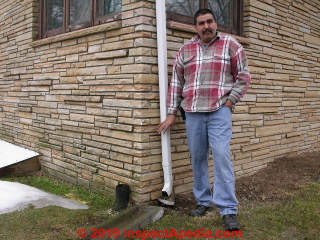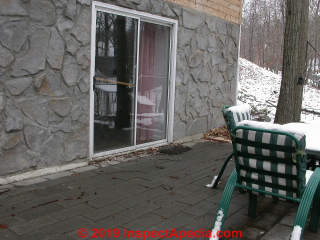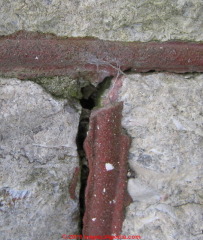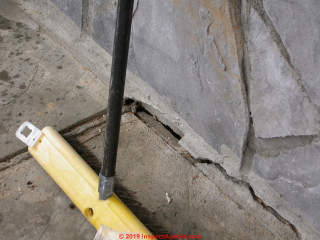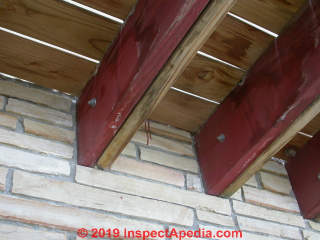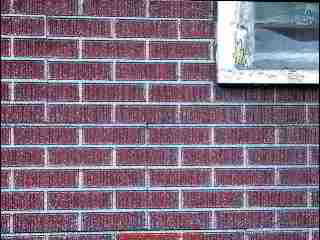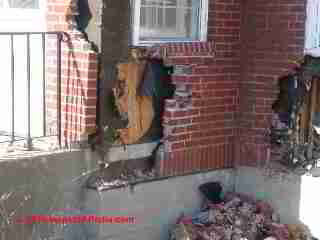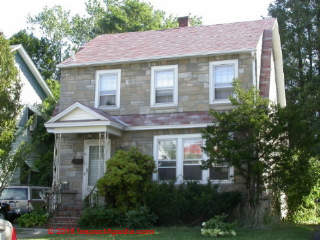 Perma-Stone Exterior Siding
Perma-Stone Exterior Siding
History, brands, photos, descriptions, & properties of faux stone & brick permastone siding
- POST a QUESTION or COMMENT about how to identify different types of building exterior siding, wall cladding, finish surfaces
Guide to building perma-stone siding & wall claddings.
Photo above: Permastone installed on a Poughkeepsie home.
This article series identifies types of building siding includes photos and descriptions of each type of building siding, including photos helpful in recognizing various types of residential building siding materials and building exterior cladding systems.
InspectAPedia tolerates no conflicts of interest. We have no relationship with advertisers, products, or services discussed at this website.
- Daniel Friedman, Publisher/Editor/Author - See WHO ARE WE?
Perma Stone faux stone, brick & similar exterior wall cladding
Here we discuss the history of and explain how to identify, inspect, install, or repair permastone type exterior wall coverings.
While there have been a number of companies, extending into the present, who use the Perma-Stone or Perma-Rock or permastone product names and brands, two of the larger producers were the Perma-Stone Company and Perma-Rock Products, Inc. who managed to fight among one another about trademark rights and violations.
Permastone or Formstone, popular in North America roughly between 1950 and 1980, could be in installed on a building using one of two very different approaches:
- Pre-fabricated permastone veneer sections were manufactured off-site, transported, nailed to the building, and joints between those sections were then filled with tooled and colored mortar.
- On-site multi-layer stucco-type application of Formstone or Permastone (two different products) were applied over expanded metal lath nailed to the building.
When it was applied as a multi-layer stucco-type coating on-site, permastone usually consisted of an expanded metal lath nailed to the building, to which three layers were applied:
- Mortar cement 3/8" to 3/4" thick, scored similarly to the scratched browncoat used in interior plaster systems
- Cement layer 1/4" to 3/8" thick
- Finished, colored, stone-patterned or tooled layer 1/4" to 3/8" thick.
As the illustration (McKee 1995) shows, the stone patterns were formed in the top cement layer by pressing forms into the still-soft final layers or by using a textured aluminum roller to form the stone surface by pressing on the wax-paper protected top surface of the cementious coating.
Once the pattern was applied to the surface grooves were cut to resemble stone mortar joints.
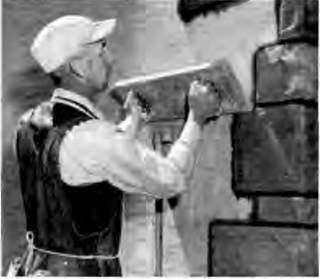 Variations in the color of the stone surface, obtained by mixing coloring agents into the top coat of mortar, gave a natural stone appearance to the finished surface. Stone colors could be gray, red, tan, brown, greenish-gray, etc.
Variations in the color of the stone surface, obtained by mixing coloring agents into the top coat of mortar, gave a natural stone appearance to the finished surface. Stone colors could be gray, red, tan, brown, greenish-gray, etc.
McKee points out that variations in color could also be applied '... by dashing colored powdered materials such as "mica, oxide pigments, stone dust, slate dust or chips of mineral or artificial stone on the outer layer. This produces a speckled surface, simulating natural rocks or stones'".
Perma-stone, also called formstone, was invented and patented by Albert Knight in 1937 and was sold by the Lasting Products Company.
Originally "formstone" was sold as a stucco product that was applied to brick row-houses as a renovation improvement in East Coast cities in the United States. (Wikipedia 2019)
Permastone or "perma-stone" is a simulated stone product sold in sheets that are fastened as a veneer layer over a building's pre-existing exterior siding or possibly directly over wall sheathing to provide what looks like a real stone or stone veneer wall.
Permastone or other simulated stone products joined asphalt siding, asbestos cement siding, and later aluminum or vinyl siding widely sold as a cover-over applied to older buildings to provide a "more attractive" or more durable exterior that required little or no maintenance (compared with painting).
The pre-existing building exterior that was a candidate for a permastone covering may have been peeling, rotted, or otherwise damaged wood clapboards, but permastone was also applied over stucco and other building exterior walls too.
Permastone was usually applied by masons as an alternative to a stone veneer, for which there remains even today a construction career category of "permastone applicator".
"Permastone" also makes an appearance under categories of synthetic stone flooring materials.
Modern restoration architects generally consider permastone to be an inappropriate treatment that is to be removed from historic buildings during a restoration or renovation project. (Roanoke undated).
Above and below, two versions of Formstone or Permastone on homes in North America. The first - above- illustrates regular rectangular long stretcher courses of stonework, while our second photo (below) illustrates a random stone pattern of Permastone.
Where was Permastone or Formstone Installed?
Permastone / Formstone was installed first in Baltimore but eventually across much of the East Coast of the U.S.
Some of the Permastone photos in this article were photographed by the author [DF] in New York and New Jersey.
Damage & Trouble-Spots in Permastone Exterior Wall Covering
Above: this cracked permastone exterior covering might be due to building settlement or simply a failure of the fasteners of the permastone expanded metal lath sheets to the building exterior or failure due to water penetration of the formstone or permastone layer sufficient to cause rust deterioration of (non-galvanized) expanded mesh or metal lath. Further investigation of this building is needed.
Above: here we see that a patio abutting a permastone exterior has settled, risking water entry and water or frost damage to the building foundation or wall.
Above: the permastone applied to this building wall was itself in good condition.
But water entry around as well as into the tops of the original (red) deck joists caused a rot problem that the owner attempted to address by sistering new treated lumber to the original joists. What may be a worry is whether or not the original joist ends still provide a secure structural connection between the deck and the building.
Asbestos in Older Cultured Stone or Faux Stone Veneer Walls
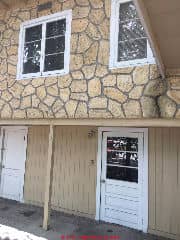 Question: does this faux stone wall contain asbestos?
Question: does this faux stone wall contain asbestos?
2019/02/14: Roxie said:
Have you seen this faux stone before? It’s on a 1953 home.. do you think it is made of asbestos ?
This question and reply were posted originally at ASBESTOS LIST of PRODUCTS
Reply:
Roxie:
I don't know. Possibly not.
It would help to know the home's country and city and to know when the stone veneer wall was installed.
Some faux brick and faux stone veneers contain asbestos but at least by a quick search, it's evident that not all of those products did so.
I have seen similar faux-stone exterior wall coverings on homes in the U.S. in the Northeast as well as the South, such as PermaStone (subject also of a trademark dispute).
Below: a home on Fountain Place in Poughkeepsie, NY
 Some of those products contained asbestos, as reflected in the following Cultured Stone or Faux Stone or "Permastone" patent disclosure in the French, Ishi, and Weir patents cited below.
Some of those products contained asbestos, as reflected in the following Cultured Stone or Faux Stone or "Permastone" patent disclosure in the French, Ishi, and Weir patents cited below.
But not all of these products contained asbestos. For example the word "asbestos" does not appear in the Stuckey or Volent patents cited below.
Also see
asbestos hazards discussed at
SYNTHETIC SLATE ASBESTOS
and at
Permastone & Formstone History & Patent Research
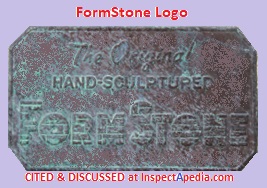 Photo: the FormStone logo and plaque installed on some buildings where this product was installed.
Photo: the FormStone logo and plaque installed on some buildings where this product was installed.
- Activa's PermaStone casting material. Contact Activa, Website: https://activaproducts.com/ Tel: 903-938-2224 / 800-883-3899
The Extra-Hard Casting Compound. Handles like plaster with stone-like results. Non-toxic powder mixes easily with water and can be cast into a virtually any mold type reproducing the finest of details with amazing durability.
Use any non-ceramic mold. The ideal casting compound when permanent break-resistant castings are desired. Finished pieces are warm bisque white - for designer finish, can be buffed to a high luster. Accepts paint, is waterproof, weatherproof and scratch resistant. - Buffalo NY, "Historic Plymouth Avenue, No. 35" [PDF] Buffalo Architecture and History, Website: https://buffaloah.com/ Email: lach@roadrunner.com
- Byrnes, Mark, Farewell Formstone? "Requiem for a Baltimore Building Material
A proposed zoning revision threatens to outlaw Formstone, ubiquitous on Baltimore's row house façades. Will anyone care?" Bloomberg Website, (December 14, 2012 ) - bloomberg.com/news/articles/2012-12-14/farewell-formstone-requiem-for-a-baltimore-building-material#:~:text=Formstone%20was%20patented%20in%20Baltimore,%22%20and%20%22maintenance%20free.%22
Article Excerpt:s
Formstone, a stucco faux-stone material, is synonymous with the Baltimore landscape. It covers row houses in blue collar neighborhoods throughout this city; ...
But Formstone may be on its way to becoming illegal here. The material is banned by Baltimore’s proposed new zoning code. If the revised code is adopted, builders would not be allowed to apply it to new housing, most commercial structures, or even to existing establishments.
Though Formstone is not dangerous, the city included it in its list of banned materials because it looks cheap and tacky.
Really? In other environs Formstone / Permastone is preserved for historic interest, as you'll read about in various publicatins here. "Cheap and tacky" might be the appearance of any building exterior in poor condition, or we might ask if for some the distinction between Formstone/Permastone and other faux brick siding such as asphalt brick panels may not have been made. See Mangus, below. - Ed. - Cohen, Charles (July 27, 1997). "Formstone lives even as many houses are shedding their fake fronts, Formstone is finding its way onto others". Baltimore Sun. Retrieved December 4, 2017.
- French, Clayton V., Stanley E. Jastremski, James E. Neal, Norman S. Greiner, Paul L. Earle, and Fred T. Randolph. "Sheet covering members for building surfaces." U.S. Patent 3,608,261, issued September 28, 1971.
Excerpt:
This invention relates to sheet covering members for building surfaces and especially to asbestos-cement shingles and strips for roofting and siding.
The covering members each comprise a base member and a denser veneer covering on said base. The covering members can be textured to simulate a natural wood grain. - Fitch, James Marston; Mary Ellen Hayward; Charles Belfoure (2001). The Baltimore Rowhouse. New York: Princeton Architectural Press. ISBN 1-56898-283-6.
- Ishii, Yasuji. "Method of manufacturing a decorative panel having an etched pattern formed thereon." U.S. Patent 3,877,958, issued April 15, 1975.
Excerpt:
DETAILED DESCRIPTION OF INVENTION Referring to the drawings, a substrate 1 employed in carrying out the invention may comprise any material such as, for example, solid asbestos sheet, hardboard, wood, mortar, concrete sheet and the like. - Mangus, Dereck Stafford, "Baltimore’s Formstone buildings are kitschy, but popular and durable" The Art Blog, September 24, 2021, web: https://www.theartblog.org/2021/09/baltimores-formstone-buildings-are-kitschy-but-popular-and-durable/
Excerpt:
For those of you unfamiliar with the term, Formstone is a kind of cheap stucco commonly applied to degraded brick or stonework building exteriors in urban areas along the East Coast of the United States.
This trompe-l’œil masonry is only shaped to look like actual stone and mortar. That is, the stonework of Formstone is completely illusory; the “stones” and “mortar” are of the same material.
Much work goes into this conceit. It’s almost like a really good forgery: the counterfeit is almost more impressive than the original. Formstone is often multi-colored and sometimes mica is sprayed on after the fake stonework dries to give it a sparkly look.
In short, Formstone is an architectural purist’s worst nightmare. - Milkovich McKee, Ann, STONEWALLING AMERICA: SIMULATED STONE PRODUCTS [PDF] National Parks Servcie, CRM. 8: 20–23. (1995)
- Pilling, Ron, "Unmuddling...Removing Formstone and other Indignities", Ron Pilling, Old-House Journal, Vol. 10, No. 9, September 1982, ISSN 0094-0178, Active Interest Media, Inc.
- Roanoke City, MASONRY ARCHITECTURAL GUIDELINES for the H-1 DISTRICT [PDF] City of Roanoke, Virginia, retrieveved 2019/12/18, original source: https://www.roanokeva.gov/DocumentCenter/View/1098/Masonry-PDF
- Stuckey, Robert B. "Method of making artificial stone brick." U.S. Patent 1,872,522, issued August 16, 1932.
- Trademark Rep. 981 (1958) Perma-Stone Company v. Perma-Rock Products, Inc., No. 9259, D.C., Maryland, April 7, 1958
- U.S. GSA, CAST STONE: CHARACTERISTICS, USES AND PROBLEMS [PDF] (2016) U.S. General Services Administration, retrieved 2020/12/15
Excerpts:
This standard includes general information on the characteristics and common uses of cast stone and identifies typical problems associated with this material along with common causes of its deterioration.
Characteristics of Cast Stone:
Made from Portland cement, sand, crushed stone, fine and coarse aggregates and water in varying proportions and formulas.
Manufactured in custom molds - either by dry-tamping or wet casting.
Dry-tamping is cast in two layers - an inner core and a facing; due to cost, only the facing material usually contains the coloring aggregates and pigments; numerous casts from the same mold can be made in the same day.
Wet-casting is one integral mix containing enough water for it to flow easily into the mold; this method produces a cast with integral coloring; typically only one piece can be cast in a mold in one day due to the high water content.
Typical aggregates used included granites, marbles and blast- furnace slag.
The strongest cast stone consisted of varying sizes of aggregates; this allowed large and small pieces to fit closely together, while cement filled in the voids.
Historically, paint was often applied to the surface for the purposes of waterproofing.
The aggregate primarily determines the cast stone color.
Veining was created by placing dye-soaked strings or thin strips of wood into the mold and then removing them before casting; the dye could then soak into the concrete mixture; veining could also be achieved by applying color or dye to the surface using a fine brush
Typical finishes include
Surfaced cast stone,
Cut cast stone, and
Plain cast stone.
Surfaced cast stone includes hand-rubbed, brushed and acid- washed finishes.
Cut cast stone includes machine-rubbed, planar-rubbed, bush- hammered and machine- and hand-tooled finishes. - U.S. GSA, Removing And Replacing Deteriorated Cast Stone Balusters [PDF] (2014) Op. Cit.
Excerpt:
This procedure includes guidance on the removal of deteriorating exterior cast stone (concrete) balusters and their replacement. - Volent, S. "Method of forming artificial stone." U.S. Patent 3,836,619, issued September 17, 1974.
- Weir, Arthur R. "Artificial stone facing plaque." U.S. Patent 3,097,080, issued July 9, 1963.
Excerpt:
The fished'sheet may be ifrorn 1/32 of an inch thick for finer laggregate up to /8 of an inch for the coarser aggregate.
In the latter case, this may include also the backing strip Iwhich preferably is of artificial asbestos cement board or the like, or at least a material which can be readily caused to adhere to a surface which it is 4 to cover by the usual commercial adhesives such as used for applying ceramic tile, plastic bathroom tile, asbestos flooring, and the like to surfaces` to be covered. - Williams, Paul K., The Faux Stone Follies, the Old House Journal, May/June 2003, pp. 66-69. Website: www.oldhousejournal.com
- Williams, Paul K., Formstone, retrieved 2020/03/09 original source: http://welcometobaltimorehon.com/things/quintessentials/formstone Paul K.Williams is president of Kelsey & Associates, Architectural Historians, (202) 462-3389, washingtonhistory.com. Adapted with permission from an article appearing in Old House Journal.
Excerpts:
Patented by Baltimorean Albert Knight in 1937 for his Lasting Products Company, its use was so widespread that in 1997 Waters made it the subject of a 30-minute documentary film Little Castles: A Formstone Phenomenon, told by the people who made it, sold it, bought it, and installed it. ...
Other brands included Rostone, Tru-Stone, Fieldstone, Bermuda Stone, Modern Stone, Romanstone, Magnolia Stone, Dixie Stone, and Silverstone. It was applied in a manner similar to stucco, usually in multiple layers, to wire net or lath attached to existing exterior walls, then scored with simulated mortar joints to suggest individual stones. Adding to the illusion were often artful coloration and sometimes mica chips that would sparkle on a sunny day.
Perma-Stone was registered as a trademark in 1929 by a Columbus, Ohio, company of the same name, which trained and authorized local dealers and provided them with the molds and materials they needed to install it. Its immediate success spurred competitors to fill the desire for a maintenance-free covering for poorly constructed exterior walls. - Wikipedia: Formstone is a type of stucco commonly applied to brick rowhouses in many East Coast urban areas in the United States, although it is most strongly associated with Baltimore.
As a form of simulated masonry, Formstone is commonly colored and shaped on the building to imitate various forms of masonry compound, creating the trompe l'oeil appearance of stone. Retrieved 2019/12/18 original source: https://en.wikipedia.org/wiki/Formstone
Other Exterior Wall Coverings Similar to PermaStone
Other Exterior Wall Coverings to Distinguish from PermaStone or Formstone
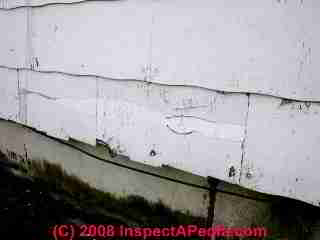
Above: asbestos cement shingle siding. See details
at ASBESTOS CEMENT & CEMENT BOARD & FIBER CEMENT SIDING
Asbestos cement siding are a hard, cementious building material made from cement and asbestos fibers as well as asbestos filler.
Fiber cement siding products are a hard, cementious material that uses (usually) wood fibers to add strength and body - replacing more hazardous asbestos fibers. For modern non-asbestos materials see details
Above: asphalt-based faux-brick siding. Some faux-stone or faux-brick veneer siding products were bonded to or made using a hardboard (wood product) base rather than an asphalt-impregnated paper or board base.
Asphalt siding: materials similar to asphalt roof shingles, used as building siding, designed to resemble brick, wood, or other materials, popular from ca 1930 - 1955.
See details
at SIDING ASPHALT SHINGLE or SHEET
Above: brick veneer wall, partly-demolished. See details at BRICK VENEER WALLS
Above: Stamped Concrete exterior walls on this home look like permastone but are not. Stamped concrete is a continuous concrete material.
STONE VENEER WALLS - some permastone products contain asbestos
...
Reader Comments, Questions & Answers About The Article Above
Below you will find questions and answers previously posted on this page at its page bottom reader comment box.
Reader Q&A - also see RECOMMENDED ARTICLES & FAQs
Question: how to find a Permastone / Formstone repair company
2020/03/09 RAK said:
Hi - I have what I believe to be Formstone or Permastone on my home, built around 1957. My front porch has a planter with this material on the outside crumbling and in desperate need of repair, if possible.
The same product on the side of my house is in excellent condition, but apparently moisture from the planter has destroyed it in this area.
How do I find someone skilled in this area to fix it? I am in an Eastern Suburb of Pittsburgh.
Reply: Repair Advice for Permastone or Formstone sided building s
It may be tricky to find a Perma-Stone repair company since the material is not in current or popular use. Here are some possible sources of repair companies who know how to work with synthetic stone and masonry veneers
- Companies specializing in repair of historic buildings can include people with specific experience repairing Formstone or Permastone - we include examples below.
- Possibly an older mason who has worked with it in the past may still be around.
- Look for "brick and stone siding repair companies" but ask if they have specific experience with your siding since otherwise they'll try to sell you a complete home re-siding job that you may not need nor want.
You might also try contacting companies and professional associations listed below. Even a company not in your immediate area may know someone qualified who is close to you.
- J.D. Walter & Co., Historic Masonry Restorations, 16617 Old Emmitsburg Rd. Emmitsburg, MD 21727 USA, Tel: 301-447-6131 Email: info@jdwalterrestorations.com Website: http://www.jdwalterrestorations.com/ - experience with repointing, stucco, formstone and veneer stone repair work
- NCMA, National Concrete Masonry Association, 13750 Sunrise Valley Drive Herndon, VA 20171 USA, Tel: 703.713.1900 email: info@ncma.org Website: https://ncma.org/
NCMA has information on current manufactured stone veneer products ncma.org/building-solutions/manufactured-stone-veneer/ including the installation and repair guide we cite just below.
MASONRY VENEER INSTALLATION GUIDE AND DETAILING OPTIONS for Compliance with ASTM C1780 [PDF] (92017), NCMA, op. cit., retrieved 2020/03/09 original source: ncma-br.org/pdfs/masterlibrary/MVMA%20Installation%20Guide%205th%20Edition%201st%20Printing.pdf
- Manufactured Stone Supply, Tel: (810) 671-0040, Email: sales@manufacturedstonesupply.com Website: manufacturedstonesupply.com
regrettably the company, who pops up when you search for MVMA Manufactured Stone Veneer Association that has now merged with the NCMA I list here, doesn't make it easy to find their actual location or address.
...
Continue reading at STONE VENEER WALLS or select a topic from the closely-related articles below, or see the complete ARTICLE INDEX.
Or see these
Recommended Articles
- ASBESTOS CEMENT & CEMENT BOARD & FIBER CEMENT SIDING
- BRICK VENEER WALLS
- GRAFFITI REMOVAL FROM BRICK CONCRETE STONE SURFACES
- SIDING ASPHALT SHINGLE or SHEET
- SIDING LEAK DIAGNOSIS & REPAIR
- SIDING TYPES, INSTALLATION, DEFECTS - home
- STAIN DIAGNOSIS on BUILDING EXTERIORS - home
- STAMPED CONCRETE CLEANING
- STONE VENEER WALLS - some permastone products contain asbestos
Suggested citation for this web page
PERMA-STONE EXTERIORS at InspectApedia.com - online encyclopedia of building & environmental inspection, testing, diagnosis, repair, & problem prevention advice.
Or see this
INDEX to RELATED ARTICLES: ARTICLE INDEX to BUILDING SIDING
Or use the SEARCH BOX found below to Ask a Question or Search InspectApedia
Ask a Question or Search InspectApedia
Try the search box just below, or if you prefer, post a question or comment in the Comments box below and we will respond promptly.
Search the InspectApedia website
Note: appearance of your Comment below may be delayed: if your comment contains an image, photograph, web link, or text that looks to the software as if it might be a web link, your posting will appear after it has been approved by a moderator. Apologies for the delay.
Only one image can be added per comment but you can post as many comments, and therefore images, as you like.
You will not receive a notification when a response to your question has been posted.
Please bookmark this page to make it easy for you to check back for our response.
IF above you see "Comment Form is loading comments..." then COMMENT BOX - countable.ca / bawkbox.com IS NOT WORKING.
In any case you are welcome to send an email directly to us at InspectApedia.com at editor@inspectApedia.com
We'll reply to you directly. Please help us help you by noting, in your email, the URL of the InspectApedia page where you wanted to comment.
Citations & References
In addition to any citations in the article above, a full list is available on request.
- A Field Guide to American Houses, Virginia & Lee McAlester (1984) ISBN-10: 0394739698 ISBN-13: 978-0394739694 includes a pictorial key and glossary to these architectural styles: Folk Houses, Native American Houses (U.S.), Pre-Railroad houses, National Architectural Styles (U.S.), Colonial Houses (1600-1820), Postmedieval English, Dutch Colonial, French Colonial, Spanish Colonial, Georgian, Adam, Early Classical Revival, Romantic Houses (1820-1880), Greek Revival style architecture, Gothic Revival style architecture, Italianate style architecture, Exotic Revivals style architecture, Octagon houses, Victorian style architecture Houses (1860-1900), Second Empire style architecture, Stick style architecture, Queen Anne style architecture, Shingle style architecture, Richardsonian Romanesque style architecture, Folk Victorian style architecture, Eclectic Houses (1880-1940), Anglo-American style architecture, English style architecture, and French Period Houses, Colonial Revival style architecture, Neoclassical style architecture, Tudor style architecture, Chateauesque style architecture, Beaux Arts style architecture, French Eclectic style architecture, Mediterranean Period Houses style architecture, Italian Renaissance style architecture, Mission style architecture, Spanish Eclectic style architecture, Monterey style architecture, Pueblo Revival style architecture, Modern Houses including Prairie style architecture, Craftsman style architecture, Modernistic style architecture, International style architecture, and American Houses Since 1940: Modern style architecture & Neoeclectic style architecture
- The American House, Mary Mix Foley, Harper Colophon Books, ISBN-0-060090831-9, ISBN-10: 0060112964 ISBN-13: 978-0060112967 1980, has been a guide we have found useful for recognizing house architectural styles
- In addition to citations & references found in this article, see the research citations given at the end of the related articles found at our suggested
CONTINUE READING or RECOMMENDED ARTICLES.
- Carson, Dunlop & Associates Ltd., 120 Carlton Street Suite 407, Toronto ON M5A 4K2. Tel: (416) 964-9415 1-800-268-7070 Email: info@carsondunlop.com. Alan Carson is a past president of ASHI, the American Society of Home Inspectors.
Thanks to Alan Carson and Bob Dunlop, for permission for InspectAPedia to use text excerpts from The HOME REFERENCE BOOK - the Encyclopedia of Homes and to use illustrations from The ILLUSTRATED HOME .
Carson Dunlop Associates provides extensive home inspection education and report writing material. In gratitude we provide links to tsome Carson Dunlop Associates products and services.



